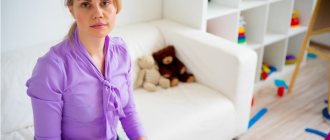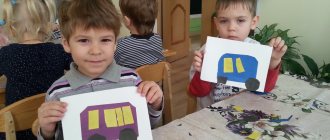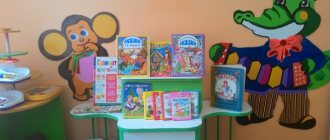Work experience “Workshop as a form of working with children”
In my report I would like to highlight this form of working with children as a workshop. Using this statement, I would like to emphasize the importance of developing creative activity in children as a factor in overall personal development and growth. The essence of the modern personality-oriented process of preschool education is the process of the child’s accumulation of such specific subjective experience, which contains means and ways of interacting with the world and thanks to this expands the child’s opportunities to actively and creatively participate in this interaction and, moreover, encourages him to acquire his own experience. Creativity in the broad sense of the word is an activity aimed at obtaining something new and unique. Therefore, the main indicator of creativity is the novelty of the created product. The result of children's creative activity, as a rule, is not distinguished by objective novelty that is significant for science, culture or production. However, the products of children's activities are new to themselves and play a huge role for the development of the child. The basis of any creativity is imagination. The preschool age of a child is characterized by activation of the functions of imagination. And if the imagination is not specifically developed during this period, then a rapid decrease in the activity of this function occurs subsequently. Along with a decrease in the ability to fantasize, a person’s ability to think creatively decreases. However, fantasy should contribute to a better knowledge of the world, self-discovery and self-improvement of the individual, and not develop into passive daydreaming. Domestic psychologists have identified indicators with the help of which children’s creativity is “recognized.” What determines the novelty of creative solutions? The novelty of creative solutions is facilitated by a broad orientation in the material before presenting any tasks, organized by an adult as an independent child experimentation that acquires a cognitive character, and the formation of generalized methods of activity encourages children to “embed” previously assigned methods into new semantic contexts. And this, in turn, leads to the generation of both new methods, new images and new meanings based on cognitive and emotional experience. What does children's creative activity contribute to? It contributes to the formation of a universal ability to construct any activity that is significant for a child, be it visual, speech, play, etc., as the creation of integrity (drawing, text, plot) from different units, but using the same techniques. “Creative workshops” are one of the modern forms of educational activities that are very attractive to children. Children love everything bright and unusual; they like to sculpt, draw, cut, stick, experiment, and design. And where else can a child realize his ideas, if not in the “workshop”? There is everything here to create. “Creative workshop” is one of the new forms of direct educational, joint and independent activity for children. Creative workshops can be used in various areas of children’s activities: for example, theater workshops, in which children can create their own costumes and attributes for performances, can be used to develop children’s communicative, aesthetic, and artistic abilities. Workshops on developing communicative abilities using problem situations and reading fiction can be used in speech development activities. Art workshops give children the opportunity to independently choose materials, direction and technique for making a craft or drawing. Workshops of good deeds will help organize work on repairing books, toys, labor education, for example, helping a junior teacher. A local history workshop will help familiarize children with the sights of their hometown, teach them to appreciate their small homeland and be a patriot. Educational workshops have the ability to create layouts and diagrams that will help children master natural knowledge, such as the basics of mathematics, chemistry, and learn about the world around them, its structure and patterns. Thus, the use of the workshop as a form of work with children is possible in a wide variety of activities; a significant advantage of this form of work is the voluntary nature of work in the workshop, the ability of children to be independent, to make choices, to develop empathy and the ability to build joint activities with peers. The work is built in stages, where each stage roughly corresponds to an age period, starting from the middle group. Within the stages, work is carried out cyclically: “Working with paper”, “Working with natural materials”, “Working with threads and fabric”. The mastered content of one cycle is integrated into other cycles. When planning material, the principle of concentricity is observed, i.e. at each stage the content increases and becomes more complex. For example: if in middle age, when working with natural materials (stones), children only examine and paint them in different colors, then in the older group they already decorate the stones, and in the preparatory group they bring them to life with the help of details. Classes in the “workshop” help children develop the basic skills and abilities provided for by the program: the ability to hold a pencil, use a brush, scissors; pick up paints, etc. and contributes to the implementation of the tasks provided for in the educational field of “Artistic and Aesthetic Development”. Creativity plays a special role, which is important at all stages of the workshop’s activities. The incentive for associative thinking plays an important role. Associations in the workshop are used to actualize the personal experience of the participants, develop the work of imagination and thereby contribute to the development of the creative process of everyone’s activity. Working with associations can be used in any type of workshop: this is one of the main technological methods for individualizing work, even with a large number of participants. The peculiarity of the “workshop” is that the children themselves decide whether to participate today or not. Creativity cannot exist under pressure and violence. It should be free, bright and unique. Without parting with pencils, felt-tip pens, and paints, the child quietly learns to observe, compare, think, and fantasize. Materials for joint activities in the form of a workshop can be very diverse: paint, paper, scissors, glue, colored pencils, felt-tip pens, different types of paper, brushes of different sizes and purposes, napkins, “waste” material: candy wrappers, threads, all kinds of scraps for cutting and stickers The creative process is a real miracle. This is confirmed by observations of how children reveal their unique abilities and the joy that creation gives them. Here they begin to feel the benefits of creativity and believe that mistakes are just steps towards achieving a goal, and not an obstacle, both in creativity and in all aspects of their lives. It is better to instill in children: “In creativity there is no right way, there is no wrong way, there is only your own way.”
Firebird
You can make a paper craft for the older group in the form of a magic bird using colored paper.
On a sheet of paper that serves as a base you need to draw the head and body of the bird. If your child doesn't draw that well yet, help him. Invite your child to decorate the bird and glue its beak and eyes from colored paper.
Next, the child can cut out several large ovals from office paper. These will be the tail feathers of the firebird. Each feather needs to be decorated. You need to draw different patterns on the feathers with pencils, felt-tip pens or paints. The finished feathers need to be glued to the back of the bird, forming a multi-colored tail.
Paper chickens
In the photos of crafts in the senior group of kindergarten you can often see voluminous paper crafts. Using this technique you can make, for example, chickens:
- Roll a sheet of yellow paper into a bag to make a cone;
- Trim the edges of the cone so that it stands firmly on the table;
- Cut out a scallop and paws from orange or red paper;
- Glue the paws to the base of the cone and the tuft to the top;
- Draw the chicken's eyes and beak.
Clown
Not all crafts in the older group bring moms and dads a lot of trouble. Sometimes it’s enough to print out a drawing from the Internet and give the child some thread.
- Print or draw a clown face;
- Glue the drawing onto a sheet of thick cardboard;
- Make holes in the top of the head using a hole punch or awl;
- Invite your child to make a clown's hair using pieces of multi-colored yarn. Pieces of yarn need to be threaded through the holes and tied with a knot.
Crafts from semolina
Crafts in the senior group of kindergarten should not only entertain, but also develop the child. Semolina paintings are great for showing physical processes.
- Draw or print a template on paper, it can be any character;
- Invite your child to coat the design with PVA glue inside the outline;
- Sprinkle semolina over the glue with your child, shake off the excess;
- When the semolina dries a little, decorate the cereal with watercolors.
The paint will spread smoothly and the semolina will swell. This technique allows you to beautifully mix colors.




